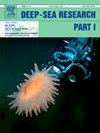丰富的分类群能较好地反映热带开阔海域中上层微生物群落的季节和深度变化
IF 2.1
3区 地球科学
Q2 OCEANOGRAPHY
Deep-Sea Research Part I-Oceanographic Research Papers
Pub Date : 2025-02-12
DOI:10.1016/j.dsr.2025.104463
引用次数: 0
摘要
了解微生物群落的季节和深度变化对预测气候变化对远洋生态系统的影响至关重要。不幸的是,这方面的一个主要障碍是,长期部署的自动化设备满足了在远离陆地的远洋获取时间序列数据的低成本要求,但这些技术很难获得覆盖整个群落的多样性数据。为了检验监测丰富的类群是否能更好地捕捉热带开阔海域中上层微生物群落的变化,采用16S rRNA和18S rRNA基因扩增子测序技术,对地球上最稳定的开阔海洋环境西太平洋暖池三个季节的整个水柱原核生物和微真核生物群落的季节和深度变化进行了研究。结果表明:光层和暗层微生物组成明显不同,且各深度微生物均有季节性变化,其中在200 m处变化最大。特异性和占用率表明,大多数季节性或深度专科是丰富的分类群。数量较多的类群与整个微生物群落相似,而数量较少的类群则完全不同。这些结果表明,丰富的分类群比稀少的分类群更能反映远洋微生物群落的季节和深度变化,为未来开发利用最少分类群进行长时间序列微生物群落动态监测的自主平台提供了基础。本文章由计算机程序翻译,如有差异,请以英文原文为准。
Abundant taxa can better indicate seasonal and depth variations of pelagic microbial communities in the tropical open ocean
Understanding seasonal and depth variations of microbial communities is essential to predict the impact of climate change on pelagic ecosystem. Unfortunately, a major barrier to this knowledge is that long-term deployed automated equipment meets the low-cost requirement for obtaining time-series data in pelagic oceans far from land, but these techniques hardly obtain diversity data covering the whole community. To test whether monitoring abundant taxa can better capture variations of pelagic microbial communities in the tropical open ocean, the seasonal and depth variations of prokaryotic and microeukaryotic communities throughout the water column over three seasons were studied using 16S rRNA and 18S rRNA gene amplicon sequencing in the western Pacific Warm Pool, where is the most stable open ocean marine environment on earth. Our results showed that photic and aphotic layers were comprised of distinct microbes, and seasonal changes of microbes occurred at all depths, which were strongest at 200 m. Specificity and occupancy indicated that most of seasonal or depth specialists were abundant taxa. The community similarity distributions of abundant taxa and the whole microbial community were similar, while that of rare taxa was completely different. These results suggested abundant taxa can better indicate seasonal and depth variations of pelagic microbial communities compared to rare taxa, which provide a basis for the future development of autonomous platforms for long time-series monitoring of microbial community dynamics using a minimal number of taxa.
求助全文
通过发布文献求助,成功后即可免费获取论文全文。
去求助
来源期刊
CiteScore
4.60
自引率
4.20%
发文量
144
审稿时长
18.3 weeks
期刊介绍:
Deep-Sea Research Part I: Oceanographic Research Papers is devoted to the publication of the results of original scientific research, including theoretical work of evident oceanographic applicability; and the solution of instrumental or methodological problems with evidence of successful use. The journal is distinguished by its interdisciplinary nature and its breadth, covering the geological, physical, chemical and biological aspects of the ocean and its boundaries with the sea floor and the atmosphere. In addition to regular "Research Papers" and "Instruments and Methods" papers, briefer communications may be published as "Notes". Supplemental matter, such as extensive data tables or graphs and multimedia content, may be published as electronic appendices.

 求助内容:
求助内容: 应助结果提醒方式:
应助结果提醒方式:


